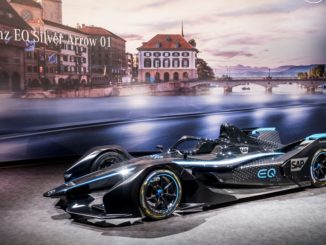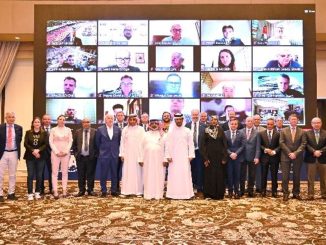
Penske Autosport team will use the Ansible Motion’s Delta S3 Driver in the Loop (DIL) simulator prepare the Formula E races.
With 48K image rendering, a full 360° wrap-around screen, real Formula E cockpit environment and Ansible Motion’s pioneering motion, vision, audio and computer solutions, Penske Autosport will benefit from a highly immersive tool to develop and improve the complex mix of powertrain, software and race strategies needed to succeed in the all-electric world championship.
Launched just two years ago, the award-winning Delta S3 dynamic DIL simulator is proving to be the go-to standard for high level motorsport teams and vehicle manufacturers to develop, refine and test vehicles and technologies in the digital domain. Honda Racing Corporation, Ford Performance, Stake F1 Team (Sauber Motorsport), Pratt Miller as well as at least one other unnamed Formula E team have previously installed Ansible Motion dynamic simulators. Now Penske Autosport will use Ansible Motion’s most advanced driving simulator to date to unlock performance and efficiency gains, benefitting from the versatility and turn-key usability for engineers and drivers alike.

Copyright 2024 © Sam Bagnall
The Delta S3’s ability to replicate highly dynamic manoeuvres in real time with ultra-low latency not only satisfied its talented and experienced drivers but also its engineers who will rely on the simulator to validate torque mapping, electro-mechanical driver controls and other specific areas which are vital to understand the sensitive inputs synonymous with getting the most from a Formula E car. Underlining its versatility, the Delta S3 connects seamlessly with on-board ECUs for the powertrain and the eight CAN bus networks used in the category’s chassis. This offers engineers and drivers the ability to interact in real-time with Hardware in the Loop (HIL) and Software in the Loop (SIL) systems – replicating what they will experience in the real car.
By focusing on a human-centric, physics-based approach to simulation, and by closely monitoring field use cases, Ansible Motion has continuously evolved its patented Stratiform six-degree-of freedom motion base (as well as its other motion and feedback systems) over the years. Penske Autosport’s simulator features a Stratiform 3 (S3) with 360° yaw capability, a large 4m by 4m ground plane motion envelope and a Quick-change Cabin System (AML QCS). Motion cueing is further enhanced by Ansible Motion’s pioneering steering, driver body loading and haptic feedback systems, which are fully integrated into the Formula E cockpit environment.
The extensive motion capability of the Delta S3 provides exceptional motion fidelity for track driving, allowing cued simulation of the large onset and sustained g-forces demanded by the teams’ proprietary vehicle and tyre physics models, and effortlessly accommodates simultaneous braking, accelerating and turning events – common on the tight street circuits which feature prominently on the Formula E calendar. The proprietary Quick-change Cabin System reduces cabin/cockpit swap times to under 30 minutes and can accommodate up to a 700kg payload.
The Delta S3 was rigorously evaluated by Penske Autosport to confirm all areas of dynamic performance such as motion control and cueing, latency and frequency response. An added benefit from Penske Autosport’s perspective is that installation of the Delta S3 simulator did not require floor reinforcements or significant groundwork, minimising installation costs and leading to its quick operational status.

Copyright 2024 © Sam Bagnall
Penske Autosport also identified other technical and cost advantages from Ansible Motion’s presence within the larger AB Dynamics group. Technical benefits include seamless integration reach into other areas and tools, including rFpro – the world’s most realistic, engineering-grade visual simulation environment. rFpro delivers accurate track surface modelling and visual content that, when coupled with Ansible Motion’s vision, motion and audio systems, maximises driver immersion and, ultimately, real-world physics correlation. Penske Autosport’s new rFpro-equipped Delta S3 simulator environment will allow trackside engineers to relay feedback to the team’s ‘mission control’ to easily update digital twin track models during race weekends. Necessary, on-demand changes – such as adding a new bump or kerb placement – can be achieved in around 30 minutes.
Human-vehicle interaction a key part of optimising performance, and that is a real differentiator for on-track success in Formula E – says Dan Clark, managing director at Ansible Motion. Our Delta S3 simulator is proving to be quite versatile, and unique, in that it’s being widely adopted by both vehicle manufacturers and top motorsport teams who are seeking to successfully connect real people with virtual development environments. We are delighted to supply Penske Autosport with a turn-key Delta S3 ecosystem that meets the team’s needs today and into the future. Drawing on the skills and integration capabilities within the wider AB Dynamics group, we are able to deliver this simulator – with unrivalled performance and value – in record time to support Penske Autosport in its pursuit of excellence.
Ansible Motion has over 14 years of experience delivering high-dynamics, high-fidelity, high-precision driving simulators to support success on and off track, at every level of professional motorsport including F1, WRC, WEC, NASCAR, INDYCAR and Formula E. Manufactured in the UK at Ansible Motion’s expanded facility, Penske Autosport’s new Delta S3 simulator was delivered in the first week of May 2024, six months after order placement, and is already operational as the team competes in Formula E’s tenth season.
Source: Ansible Motion







Be the first to comment